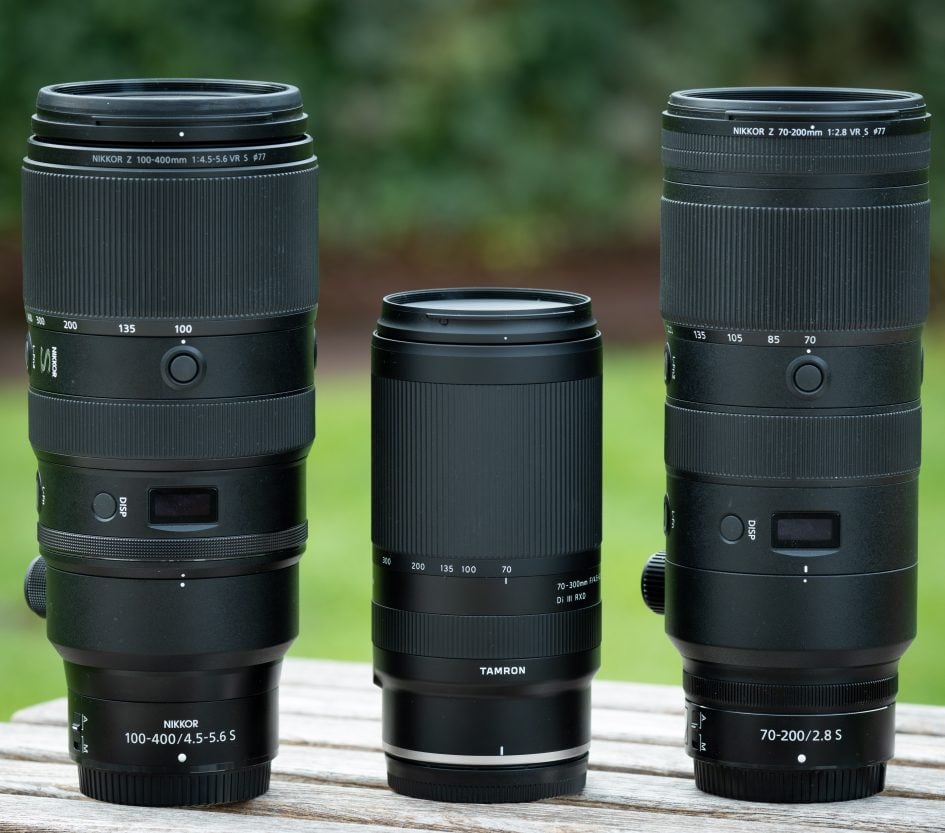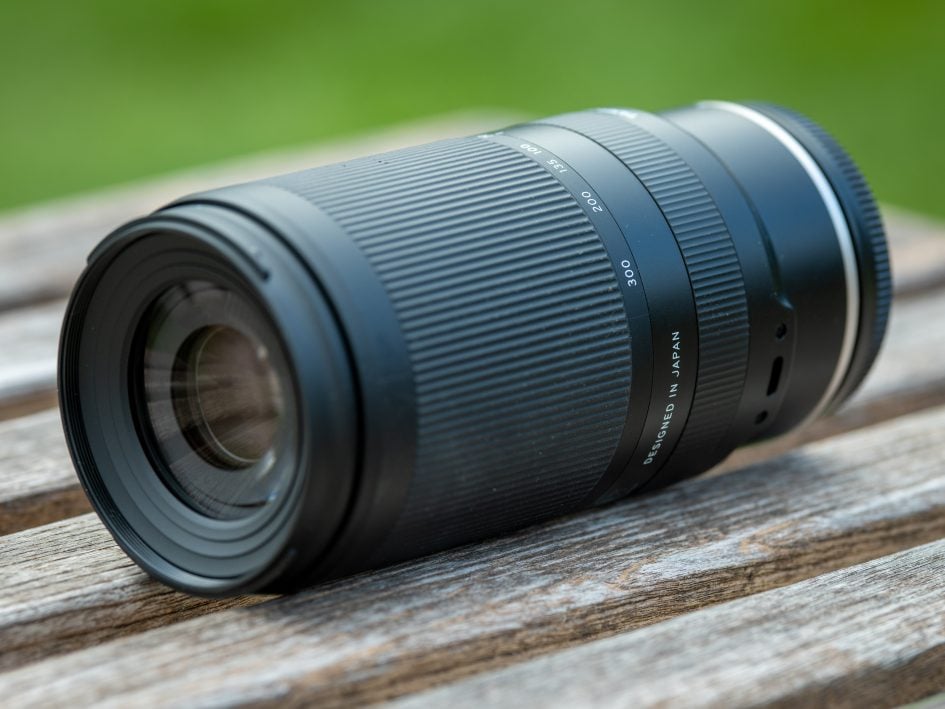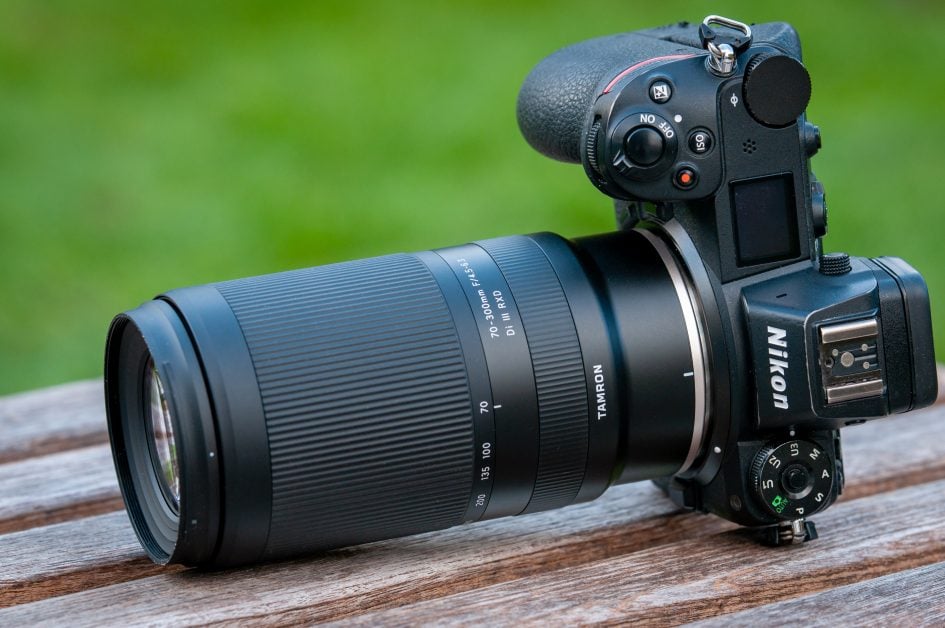Tamron 70-300mm f4.5-6.3 Di III review
-
-
Written by Thomas
Intro
In October 2020 Tamron introduced the 70-300mm f4.5-6.3 Di III RXD (model A047) for the Sony E-mount. Now this 4.3x zoom becomes Tamron’s first lens for the Nikon Z-mount – and it’s currently the only lens for Z-mount with this zoom range. Nikon is clearly adopting a two-pronged approach with respect to licensing: for some lenses, Nikon’s decided to build or brand their own versions of Tamron’s optical designs (for example, the Z 18-28mm f2.8, Z 28-75mm f2.8, Z 70-180 f2.8), while the 70-300mm here is clearly a Tamron-branded model and more are likely to follow. This is good news as the portfolio of autofocus lenses for Nikon Z-mount is sure to expand even further and offer more choices for photographers using Nikon mirrorless cameras.
Tamron’s 70-300mm is a single barrel extending design with full weather-sealing. The lens is lightweight at 577g (without lens hood) and has the same 67mm filter-thread as the Nikon Z 17-28mm f2.8, Z 28-75mm f2.8, and (presumably) the Z 70-180 f2.8. And for those who like to capture small objects the 70-300mm f4.5-6.3 Di III allows for a maximum magnification of 1:4.6 at the long end with a good working distance. Sadly it lacks optical image stabilization and relies solely on the sensor based stabilization of Nikon’s full-frame Z-mount bodies. Which is a pity if you want to use the lens on one of Nikon’s cropped sensor cameras.
The lens is made in China and is available for 660 EUR / 700 USD / 660 GBP. The version for Sony E-mount currently sells for only 470 EUR / 500 USD / 520 GBP but this is over two years after the introduction of the lens – at 699 EUR. PS – if you’re interested in Tamron’s other full-frame telephoto zoom lenses which will (in case of the 70-180mm) or might end up with a Z-mount check out my in-depth reviews of the Tamron 70-180mm f2.8 Di III VXD, Tamron 50-400mm f4.5-6.3 Di III VC, and Tamron 150-500mm f5-6.7 Di III VC (tested as E-mount versions).
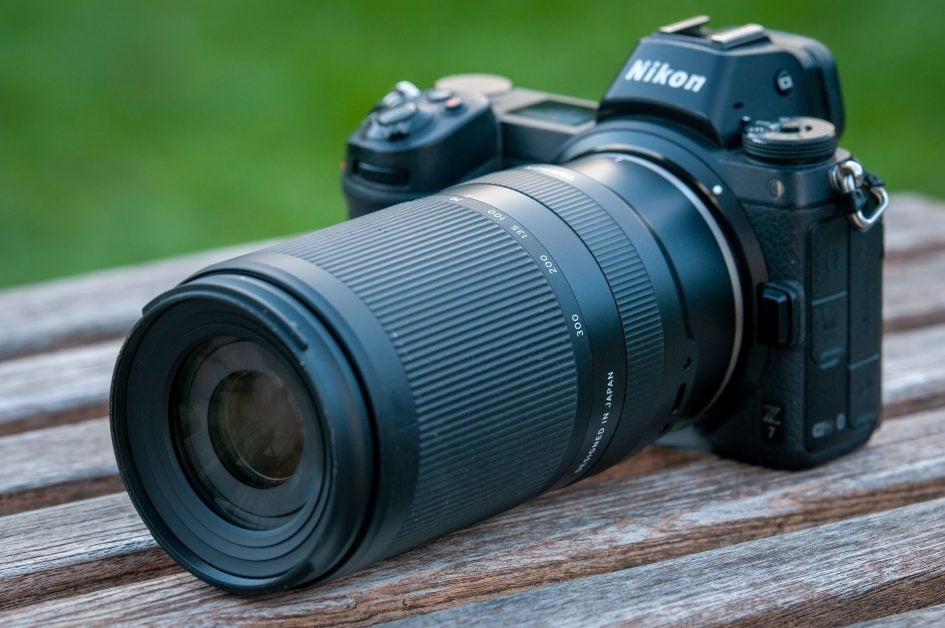
Facts and features
Let’s compare the new Tamron 70-300mm f4.5-6.3 Di III (“Tamron 70-300” for short) to the Nikon Z 100-400mm f4.5-5.6 VR S (“Z-Nikkor 100-400”) and Nikon AF-P 70-300mm f4.5-5.6E ED VR (“F-Nikkor 70-300”) which was introduced in 2015 and still can be used via FTZ adapter on Nikon’s Z cameras. As usual I’ve rated the features with a [+] (or [++]), when it’s better than average or even state of the art, a [0] if it’s standard or just average, and [-] if there’s a disadvantage.
Size (diameter x length): 77 x 150mm (3.0 x 5.9in.) plus 67mm for the lens hood. The F-Nikkor 70-300 is 81 x 146mm + 78mm lens hood. Add 30mm for the FTZ adapter to use it on a Nikon Z camera. The Z-Nikkor 100-400 is 98 x 222mm + 65mm lens hood. All three lenses in this comparison extend when zoomed to their longest focal length: The Tamron 70-300 extends to a maximum total length (incl. lens hood) of 277mm, the F-Nikkor 70-300 to 310mm (incl. FTZ adapter), the Z-Nikkor 100-400 to 336mm. [+]
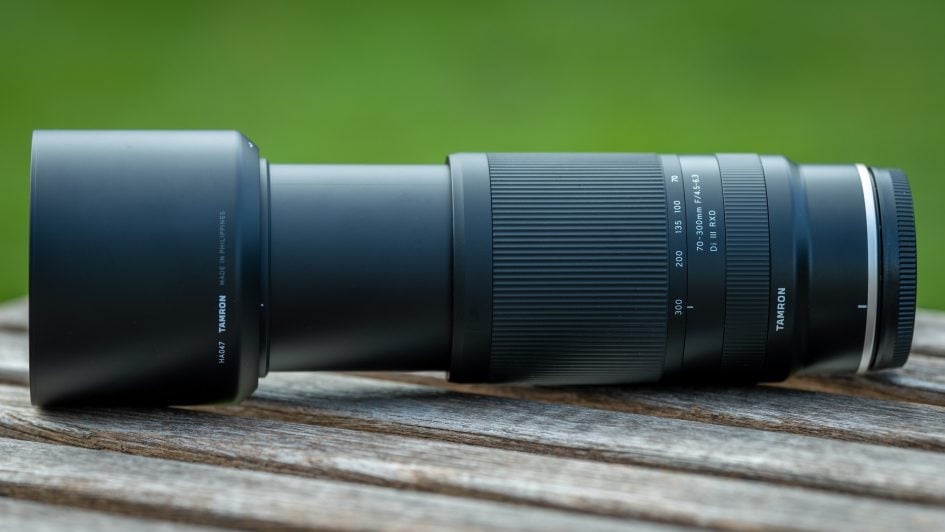
Weight: At 577g (1.3 lb.) plus 62g for the lens hood the Tamron 70-300 is almost 100g lighter than the F-Nikkor 70-300 even before accounting for the 133g of the FTZ adapter you’ll need for the F-Nikkor. The Z-Nikkor 100-400 is much heavier at 1355g + 63g lens hood + 82g tripod foot. [+]
Optics: The Tamron 70-300mm f4.5-6.3 Di III has 15 optical elements in 10 groups including one special dispersion element but no aspherical elements. The F-Nikkor 70-300 has 18 elements in 14 groups, the Z-Nikkor 100-400 is a 25/20 design. Only the Z-Nikkor 100-400 has fluorine coating at the front lens to repel water, dust, and dirt and make cleaning easier. [+]
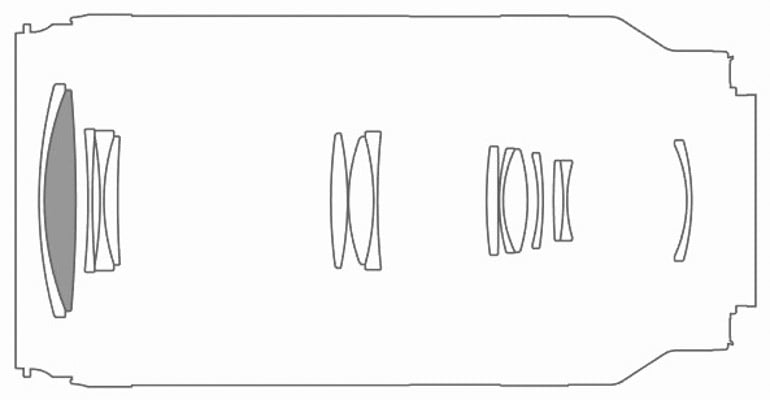
Minimum object distance is 0.67m (2.2ft.) with a magnification of 1:7.4 and a working distance of 0.50m at 70mm focal length. At 300mm focal length maximum magnification is 1:4.6 which is not bad and results in a working distance of 1.2m. A magnification of 1:10 is achieved at 3.06m. The F-Nikkor 70-300 achieves 1:3.8 at 300mm focal length and 0.97m working distance. The Z-Nikkor 100-400 achieve its maximum magnification of 1:2.5 at 400mm focal length and 0.68m working distance. [0]
Focal ratio: All lenses in this comparison have a focal ratio which becomes smaller the further you zoom in. The Tamron 70-300 starts at f4.5 at 70mm focal length and reduces its focal ratio to f4.8 from 88mm, f5.0 from 116mm, f5.3 from 144mm, f5.6 from 175mm, f6.0 from 217mm, and f6.3 from 268mm onwards. The F-Nikkor 70-300 is a bit brighter (1/3 of a stop at the long end), same with the Z-Nikkor 100-400. [0]
Use with teleconverters: No, neither the Tamron nor the F-Nikkor can be used with Nikon teleconverters. Only the Z-Nikkor 100-400 can use Nikon’s Z TC-1.4x and Z TC-2.0x. [0]
Filter-thread: 67mm, same as the F-Nikkor 70-300. The Z-Nikkor 100-400 needs 77mm filters. [+]
Image stabilization: No, the Tamron 70-300 solely relies on the sensor based stabilization of Nikon’s full-frame Z-mount bodies. Both Nikkor lenses have optical stabilization (VR). [0]
Autofocus: All lenses in this comparison offer autofocus with built-in focus drive. Manual-focus override is by simply turning the dedicated focus ring. On the Tamron 70-300 the focus ring turns the way Nikon users are used to and it has the non-linear gearing which most lenses for mirrorless cameras offer. But although the lens has a USB-C port to connect via computer to Tamron’s lens Utility (TLU) you cannot switch between variable or linear gearing nor can the direction of the ring be reversed – as you can do with the Z-Nikkor 100-400. Focus on the F-Nikkor 70-300 works differently as it has a direct linear mechanical coupling between the focus ring and the focus action. [+]
Indicators/display: The Tamron 70-300 does not feature a distance or dof indicator on the focus ring like the F-Nikkor. The Z-Nikkor 100-400 has an OLED display indicating focal length, aperture, or focusing distance (in m or ft.) and depth-of-field. [0]
All lenses in this comparison cover full frame sensors or can equally be used on a cropped APS-C/DX camera body. [+]
Price: The Tamron 70-300 costs 660 EUR (incl. 19% VAT) / 700 USD / 660 GBP. The F-Nikkor 70-300 currently sells for 600 EUR / 600 USD / 630 GBP, the Z-Nikkor 100-400 is much more expensive 3000 EUR / 2700 USD / 2600 GBP. [+]
The Tamron 70-300 comes without a pouch or tripod mount but the reversible lens hood is included. Both Nikkors come with a pouch, the Z-Nikkor also has a tripod foot. [0]
Aperture ring and other control elements: The focus ring on the Tamron 70-300 can be assigned in camera to operate the aperture, exposure compensation, or ISO sensitivity – or simply switched off. This is similar to the multi-function control ring on the Z-Nikkor 100-400 but there are no other control elements/buttons/switches. The F-Nikkor 70-300 has no aperture ring but sports two switches to control focus and VR mode. [+]
Sealing: All three lenses in this comparison have a rubber grommet at the lens-mount plus further weather-sealing throughout the construction. [+]
At a score of 0[-]/6[0]/9[+] the Tamron 70-300mm f4.5-6.3 Di III is an affordable, light, and relatively small lens reaching 300mm focal length with an attractive 4.3x zoom range. It has a customizable focus/function ring, is thoroughly sealed against the elements, and can reach magnifications of 1:4.6 at a very usable working distance.
Above from left to right: Nikon Z 100-400mm f4.5-5.6 VR S, Tamron 70-300mm f4.5-6.3 Di III, Nikon Z 70-200mm f2.8 VR S
Coverage
With its 4.3x zoom-range the Tamron 70-300 covers angles of view from 37 degrees to 8 degrees (diagonally) and extends the reach of a standard 24-70mm (or 28-75mm) zoom nicely and without gap. Compared to the 24 degrees of zooms starting at 100mm and 6 degrees at 400mm the difference is quite obvious and could be the decisive factor for choosing a telephoto zoom lens:
Above: Tamron 70-300mm f4.5-6.3 Di III coverage on a full-frame camera at 70mm (left) and 300mm (right)
Above: Nikon Z 100-400mm f4.5-5.6 VR S coverage on a full-frame camera at 100mm (left) and 400mm (right)
At the long end a 100-400mm zoom offers 33% more reach/magnification than the Tamron 70-300. To get the same angle-of-view of 400mm focal length you need to crop 1.33x into an image shot at 300mm. This would result in a reduction of resolution from e.g. 45MP to around 25MP – which might still be enough for the intended purpose.
Focus and zoom
Focus accuracy and repeatability is critical to consistently produce sharp shots. Repeatability (the accuracy of focus on the same subject after repeated focus-acquisition) of the Tamron 70-300mm f4.5-6.3 Di III is very good (measured 98.7% in Reikan FoCal) with no outliers over a series of 40 shots. The lens focuses in around 0.5 sec from infinity at 200mm focal length to 2.17m (1:10 magnification), which is similar to the Z-Nikkor 100-400 but a bit slower than the F-Nikkor 70-300 (on a D810).
The zoom ring has a pretty short throw of 70 degrees and has a 57mm wide rubber surface with a good grip. It turns with quite some resistance and cannot be operated with one finger. The lens shows zoom creep and has no lock to prevent it. The focus ring is 14mm wide and is located closer to the camera. It also has a rubberized surface and moves with more resistance than on a Z-Nikkor.
AF-operation of the lens in photo-mode can be heard as a very low hum from the outside but if you record video with the built-in microphone AF is practically silent.
As you pull focus, you’ll notice very little focus breathing: the image became 1% more magnified when I adjusted focus from infinity to 2.17m at 200mm focal length. This is hardly distracting when shooting videos. Same at 70mm focal length.
I also tested whether Tamron’s zoom lens allows you to change the focal length without altering its focus. This characteristic is called parfocal. I focused the lens at 300mm and then zoomed back checking focus on the way. The 70-300mm f4.5-6.3 Di III obviously employs a control curve in firmware because when zoomed very fast, the lens lost focus only to snap back in focus when I slowed down or stopped – but not quite perfect. See the following 100% crops shot at f5.0 and a focal length of 125mm before and after re-focusing:

This small focus error probably is not relevant when shooting video, but when shooting stills it’s best to re-focus after changing the focal length.
Image stabilization
To test the effectiveness of the image stabilization with the Tamron 70-300mm f4.5-6.3 Di III on a Nikon Z 7 camera body, I did a series of 140 test-shots hand-held at 300mm focal length with shutter speeds from 1/320 of a second down to 1/10 sec. I used the shots at 1/320 sec with VR=off as reference of how good my handholding was at the time of the test and Reikan FoCal did the chore of evaluating the sharpness of all shots.
Here’s the results: With VR=on the combined stabilization from lens and camera produced only 2 outliers in the 80 shots down to 1/40 sec (3 stops) but the rest was clearly better than the average sharpness at 1/320 sec with VR=off. At 1/20 sec (4 stops) I had still had only three mild outliers over 20 shots but at 1/10 sec (5 stops) results became very erratic and on average worse than at 1/320 sec with VR=off. This is a pretty impressive performance of the sensor-based image stabilization working solo at 300mm focal length of 4 stops.
Next check out my quality results!
Check prices on the Tamron 70-300mm f4.5-6.3 Di III at B&H, Adorama, WEX UK or Calumet.de. Alternatively get yourself a copy of my In Camera book, an official Cameralabs T-shirt or mug, or treat me to a coffee! Thanks!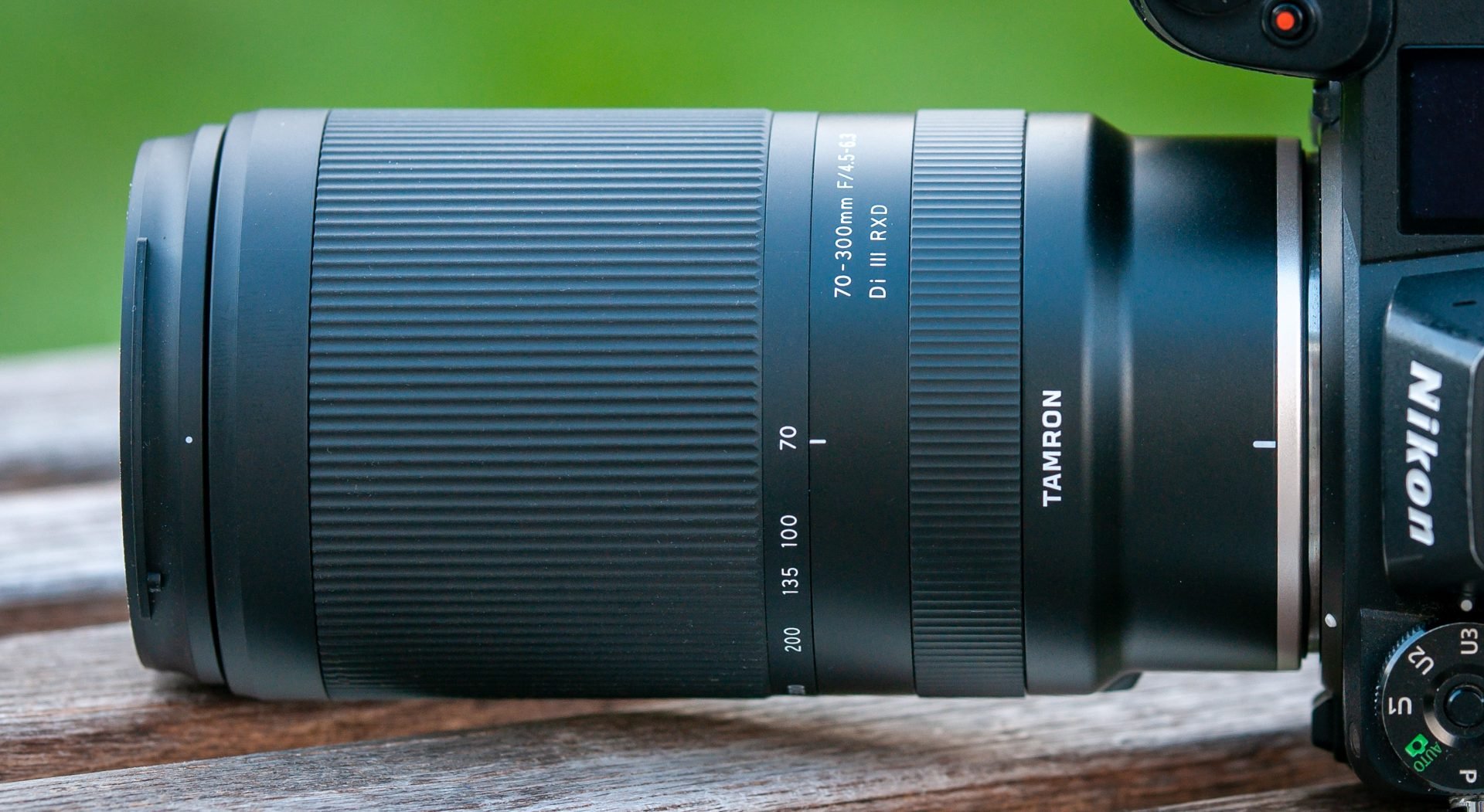
 The 70-300mm f4.5-6.3 Di III is a worthy first lens from Tamron for Nikon's Z-mount (and it's also available in Sony e-mount). It fills a gap in Nikon's line-up of Z-Nikkors and is affordable, light, and pretty well equipped with a customizable focus / function ring, thorough weather sealing, and a maximum magnifications of 1:4.6 at a very good working distance. It produces sharp to very sharp images at all focal lengths across the full frame - except at 70mm where corner performance is severely hampered by field-curvature. AF is fast and reliable and even Bokeh is quite nice for an f4.5-6.3 lens. Only the missing optical image stabilization makes the lens not the best choice for Nikon's non-stabilized cropped sensor cameras. But other than that Tamron's 70-300mm f4.5-6.3 Di III clearly earns a Recommendation.
The 70-300mm f4.5-6.3 Di III is a worthy first lens from Tamron for Nikon's Z-mount (and it's also available in Sony e-mount). It fills a gap in Nikon's line-up of Z-Nikkors and is affordable, light, and pretty well equipped with a customizable focus / function ring, thorough weather sealing, and a maximum magnifications of 1:4.6 at a very good working distance. It produces sharp to very sharp images at all focal lengths across the full frame - except at 70mm where corner performance is severely hampered by field-curvature. AF is fast and reliable and even Bokeh is quite nice for an f4.5-6.3 lens. Only the missing optical image stabilization makes the lens not the best choice for Nikon's non-stabilized cropped sensor cameras. But other than that Tamron's 70-300mm f4.5-6.3 Di III clearly earns a Recommendation.